stop start TOYOTA GT86 2017 (in English) Workshop Manual
[x] Cancel search | Manufacturer: TOYOTA, Model Year: 2017, Model line: GT86, Model: TOYOTA GT86 2017Pages: 505, PDF Size: 9.9 MB
Page 236 of 505
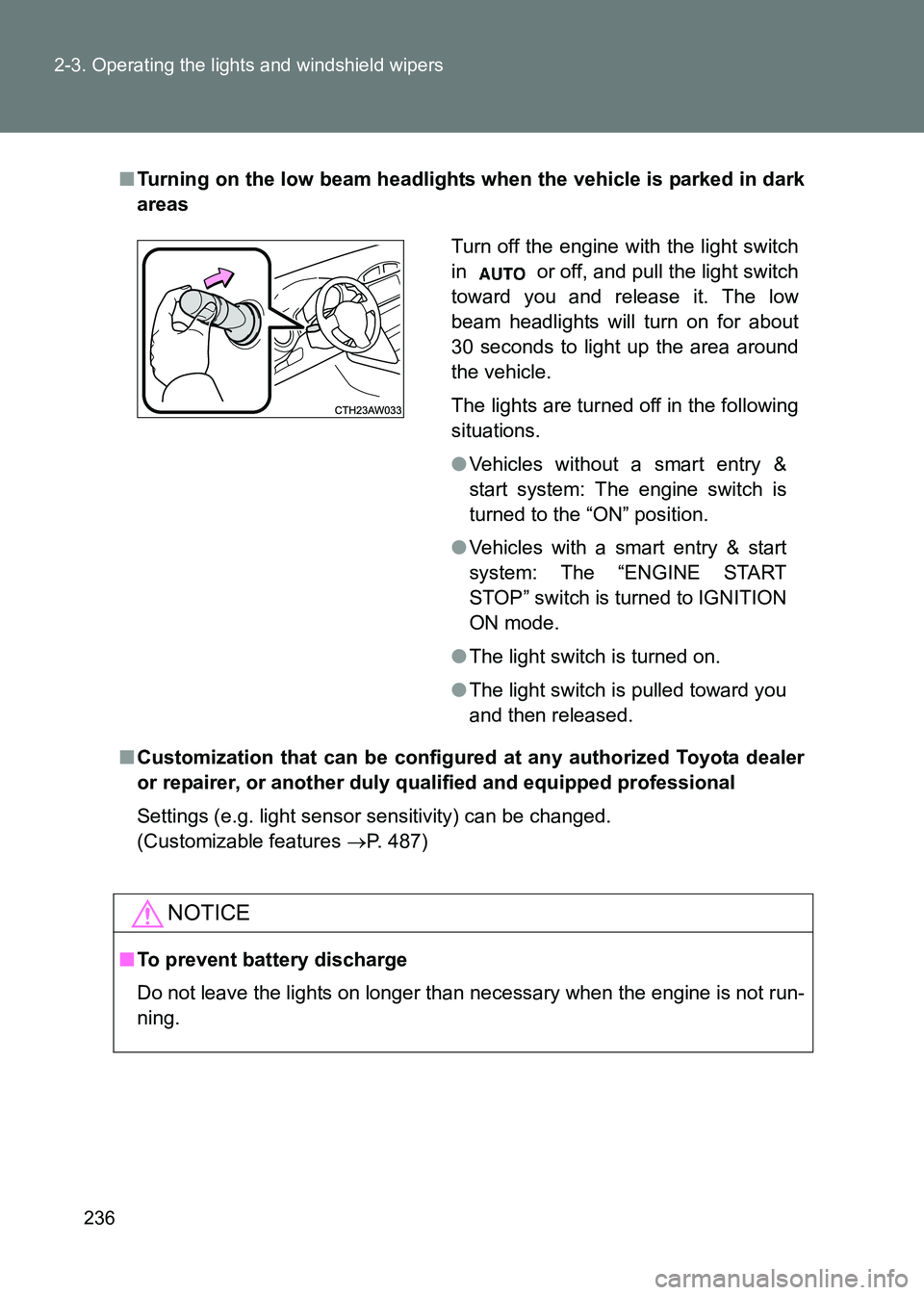
236
2-3. Operating the lights and windshield wipers
86_EE (OM18071E)
■
Turning on the low beam headlights when the vehicle is parked in dark
areas
■ Customization that can be configured at any authorized Toyota dealer
or repairer, or another duly qualified and equipped professional
Settings (e.g. light sensor sensitivity) can be changed.
(Customizable features →P. 487)
NOTICE
■To prevent battery discharge
Do not leave the lights on longer than necessary when the engine is not run-
ning.
Turn off the engine with the light switch
in or off, and pull the light switch
toward you and release it. The low
beam headlights will turn on for about
30 seconds to light up the area around
the vehicle.
The lights are turned off in the following
situations.
●Vehicles without a smart entry &
start system: The engine switch is
turned to the “ON” position.
● Vehicles with a smart entry & start
system: The “ENGINE START
STOP” switch is turned to IGNITION
ON mode.
● The light switch is turned on.
● The light switch is pulled toward you
and then released.
Page 239 of 505
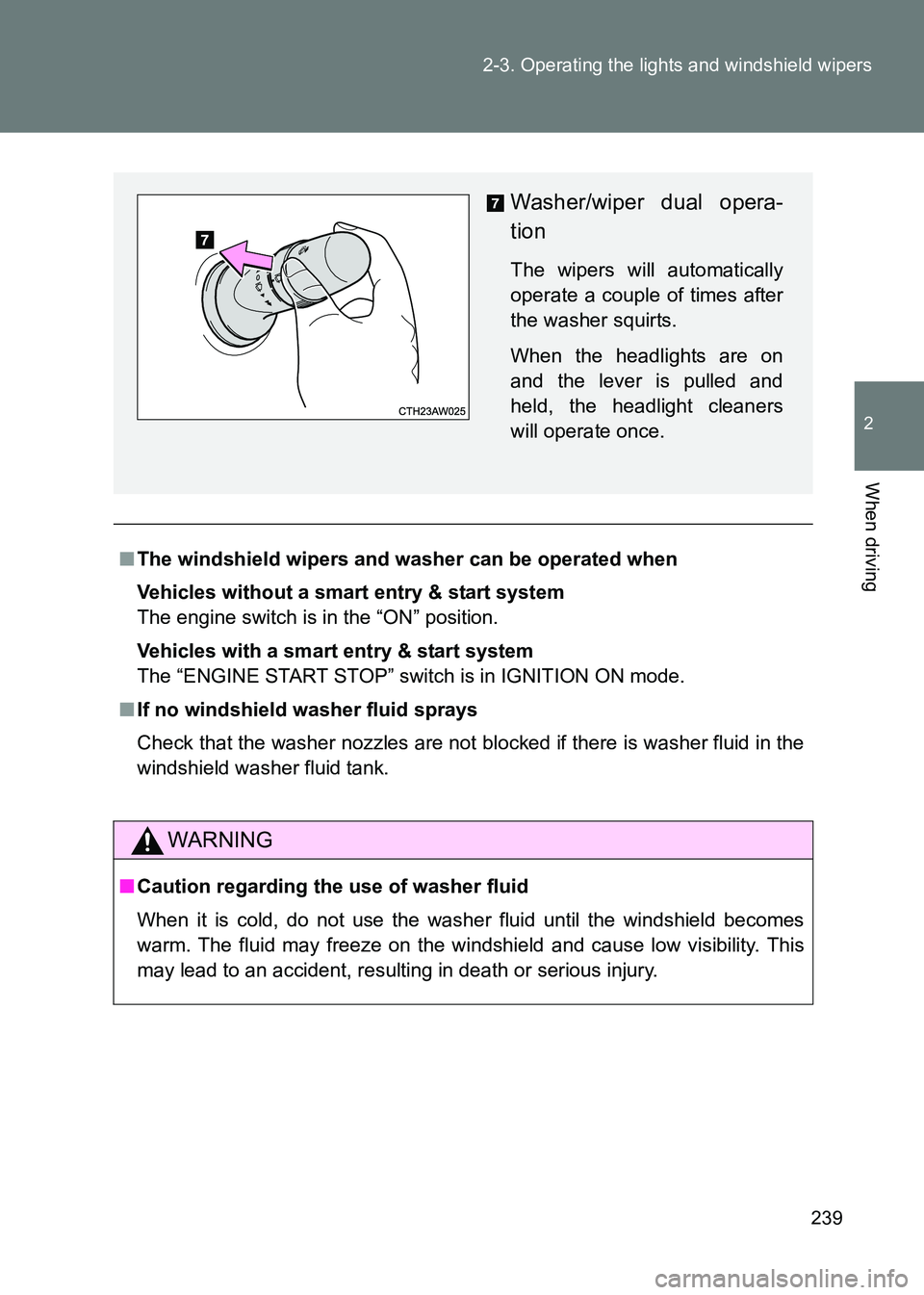
239
2-3. Operating the lights and windshield wipers
2
When driving
86_EE (OM18071E)
■
The windshield wipers and washer can be operated when
Vehicles without a smart entry & start system
The engine switch is in the “ON” position.
Vehicles with a smart entry & start system
The “ENGINE START STOP” switch is in IGNITION ON mode.
■ If no windshield washer fluid sprays
Check that the washer nozzles are not blocked if there is washer fluid in the
windshield washer fluid tank.
WARNING
■Caution regarding the use of washer fluid
When it is cold, do not use the washer fluid until the windshield becomes
warm. The fluid may freeze on the winds hield and cause low visibility. This
may lead to an accident, resulting in death or serious injury.
Washer/wiper dual opera-
tion
The wipers will automatically
operate a couple of times after
the washer squirts.
When the headlights are on
and the lever is pulled and
held, the headlight cleaners
will operate once.
Page 246 of 505
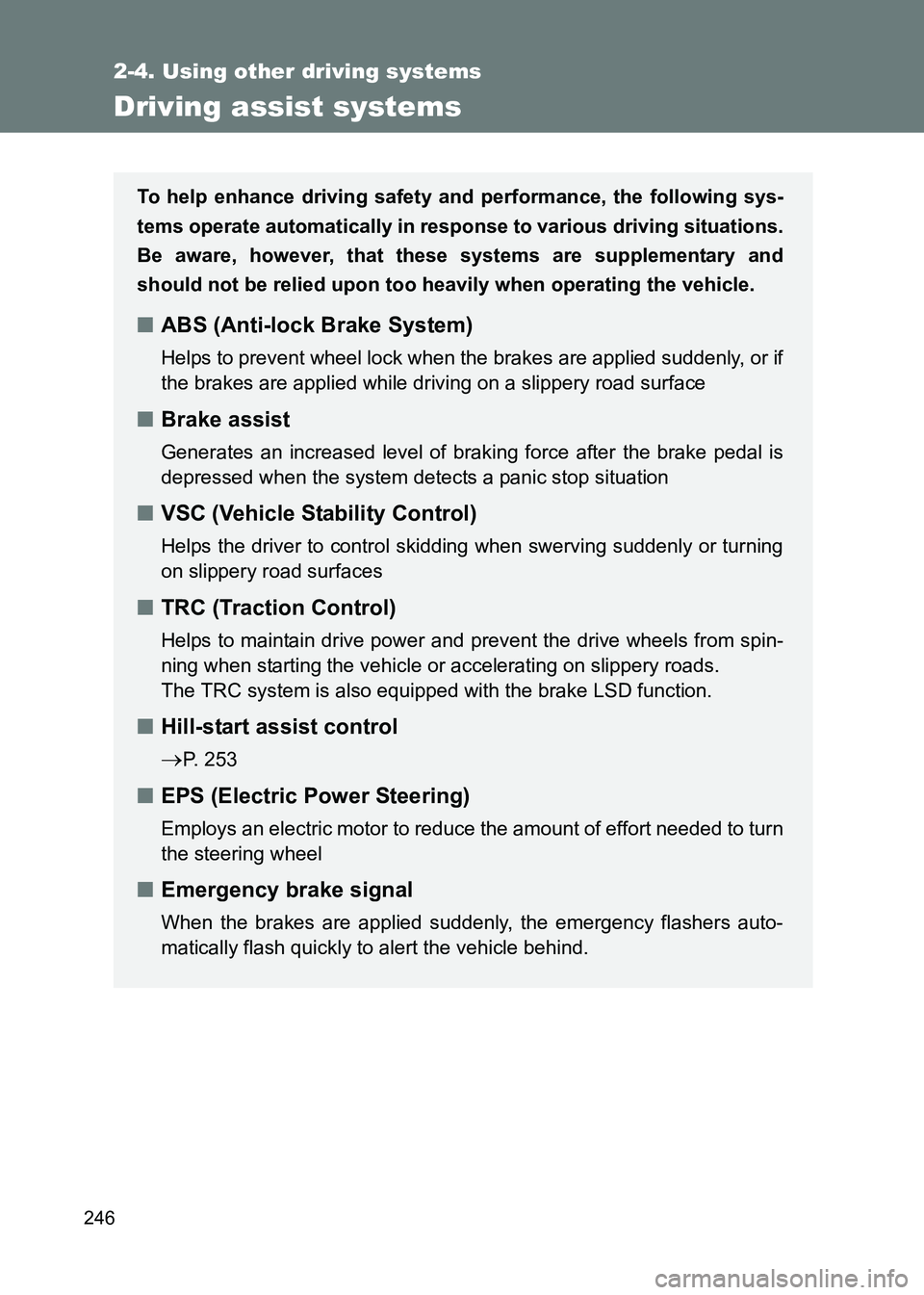
246
2-4. Using other driving systems
86_EE (OM18071E)
Driving assist systems
To help enhance driving safety and performance, the following sys-
tems operate automatically in response to various driving situations.
Be aware, however, that these systems are supplementary and
should not be relied upon too heavily when operating the vehicle.
■ ABS (Anti-lock Brake System)
Helps to prevent wheel lock when the brakes are applied suddenly, or if
the brakes are applied while driving on a slippery road surface
■Brake assist
Generates an increased level of braking force after the brake pedal is
depressed when the system detects a panic stop situation
■VSC (Vehicle Stability Control)
Helps the driver to control skidding when swerving suddenly or turning
on slippery road surfaces
■TRC (Traction Control)
Helps to maintain drive power and pr event the drive wheels from spin-
ning when starting the vehicle or accelerating on slippery roads.
The TRC system is also equipped with the brake LSD function.
■ Hill-start assist control
→
P. 253
■EPS (Electric Power Steering)
Employs an electric motor to reduce the amount of effort needed to turn
the steering wheel
■Emergency brake signal
When the brakes are applied suddenly, the emergency flashers auto-
matically flash quickly to alert the vehicle behind.
Page 249 of 505

249
2-4. Using other driving systems
2
When driving
86_EE (OM18071E)
Selecting TRC mode and VSC mode
Modes can be selected to suit your driving conditions as follows:
*1: Vehicles with an automatic transmission
*2: Vehicles with a manual transmission
Driving
conditionsTRC
modesVSC modesBrake LSD functionIndicator lights
Normal roadsNormal mode Normal
mode Normal
mode
Rough roads OffNormal
mode Normal
mode
Sport
driving “TRACK”
mode “TRACK”
mode “TRACK”
mode
Off Off “TRACK”
mode
*1
Off
*2
■ Sounds and vibrations caused by the ABS, brake assist, TRC and VSC
systems
●A sound may be heard from the engine compartment when the brake
pedal is depressed repeatedly, when the engine is started or just after the
vehicle begins to move. This sound does not indicate that a malfunction
has occurred in any of these systems.
● Any of the following conditions may occur when the above systems are
operating. None of these indicates that a malfunction has occurred.
• Vibrations may be felt through the vehicle body and steering.
• A motor sound may be heard after the vehicle comes to a stop.
• The brake pedal may pulsate slightly after the ABS is activated.
• The brake pedal may move down slightly after the ABS is activated.
■ EPS operation sound
When the steering wheel is operated, a motor sound (whirring sound) may
be heard. This does not indicate a malfunction.
Page 250 of 505

250
2-4. Using other driving systems
86_EE (OM18071E)
■
Automatic reactivation of TRC and VSC systems
After turning the TRC and VSC systems off, the systems will be automati-
cally reactivated in the following situations:
●Vehicles without a smart entry & start system: When the engine switch is
turned to “LOCK” position
● Vehicles with a smart entry & start system: When the “ENGINE START
STOP” switch is turned off
● If only the TRC system is turned off, the TRC will turn on when vehicle
speed is more than approximately 50 km/h (31 mph).
If both the TRC and VSC systems are turned off, automatic reactivation
will not occur when vehicle speed increases.
■ Reduced effectiveness of the EPS system
The effectiveness of the EPS system is reduced to prevent the system from
overheating when there is frequent steer ing input over an extended period of
time. The steering wheel may feel heavy as a result. Should this occur,
refrain from excessive steering input or stop the vehicle and turn the engine
off. The EPS system should return to normal after a little while.
■ Automatic deactivation of “TRACK” mode
Vehicles without a smart entry & start system
When the engine switch is turned to “LOCK” position after driving in
“TRACK” mode, the mode is automatically deactivated.
Vehicles with a smart entry & start system
When the “ENGINE START STOP” switch is turned off after driving in
“TRACK” mode, the mode is automatically deactivated.
■ Operating conditions of emergency brake signal
When the following three conditions are met, the emergency brake signal
will operate:
●The emergency flashers are off.
● Actual vehicle speed is over 60 km/h (38 mph).
● The brake pedal is depressed in a manner that cause the system to
judge from the vehicle deceleration that this is a sudden braking opera-
tion.
Page 253 of 505
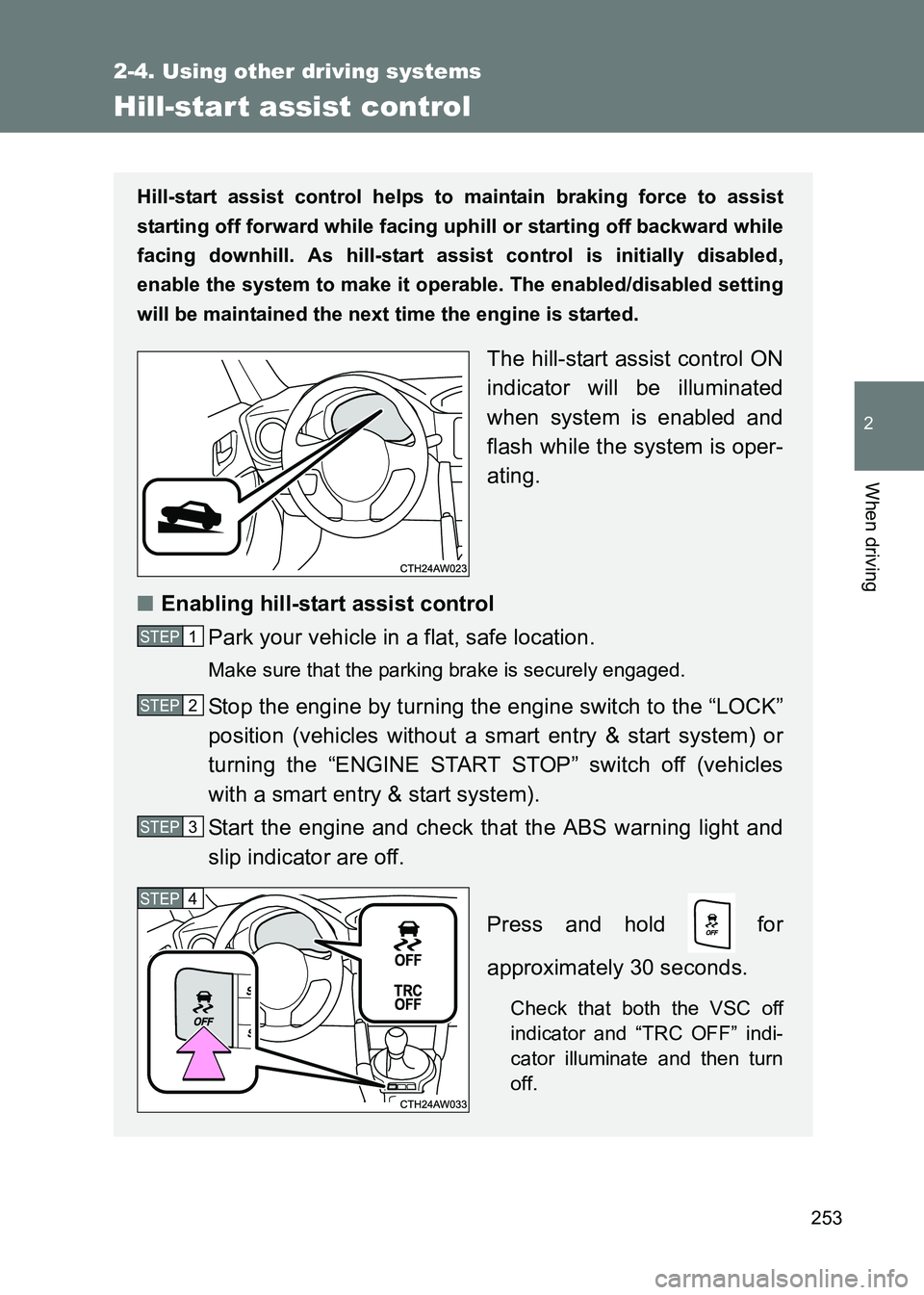
253
2-4. Using other driving systems
2
When driving
86_EE (OM18071E)
Hill-star t assist control
Hill-start assist control helps to maintain braking force to assist
starting off forward while facing uphill or starting off backward while
facing downhill. As hill-start assist control is initially disabled,
enable the system to make it oper able. The enabled/disabled setting
will be maintained the next time the engine is started.
The hill-start assist control ON
indicator will be illuminated
when system is enabled and
flash while the system is oper-
ating.
■ Enabling hill-start assist control
Park your vehicle in a flat, safe location.
Make sure that the parking brake is securely engaged.
Stop the engine by turning the engine switch to the “LOCK”
position (vehicles without a smart entry & start system) or
turning the “ENGINE START STOP” switch off (vehicles
with a smart entry & start system).
Start the engine and check that the ABS warning light and
slip indicator are off.
Press and hold for
approximately 30 seconds.
Check that both the VSC off
indicator and “TRC OFF” indi-
cator illuminate and then turn
off.
STEP 1
STEP 2
STEP 3
STEP 4
Page 254 of 505

254
2-4. Using other driving systems
86_EE (OM18071E)
■
When enabling the hill-start assist control
●If the hill-start assist control ON indicator does not illuminate or if an
incorrect operation is performed, turn the engine switch to the “LOCK”
position (vehicles without a smart entry & start system) or turn the
“ENGINE START STOP” switch off (vehicles with a smart entry & start
system) and then restart the enabling procedure from .
● If is pressed and held for approximately 30 seconds or more, the
VSC off indicator and “TRC OFF” indicator will turn off and subsequent
operations of the switch will be rejected. In this case, the VSC system will
operate in normal mode. ( →P. 249) To enable , turn the engine
switch to the “ACC” or “LOCK” posit ion (vehicles without a smart entry &
start system) or turn the “ENGINE START STOP” switch off (vehicles
with a smart entry & start system) and then restart the engine.
Within 5 seconds after the indicator lights turn off, release
. Then, press the switch again within 2 seconds of
releasing it.
The hill-start assist control ON indicator will illuminate and then
turn off.
Turn the engine switch to the “LOCK” position (vehicles
without a smart entry & start system) or turn the “ENGINE
START STOP” switch off (vehicles with a smart entry &
start system). Then, restart the engine and check that the
hill-start assist control ON indicator is illuminated.
Hill-start assist control is enabled when the indicator is illumi-
nated.
To disable hill-start assist control, perform the above
through again.
STEP 5
STEP 6
STEP 1
STEP 6
STEP 4
Page 255 of 505
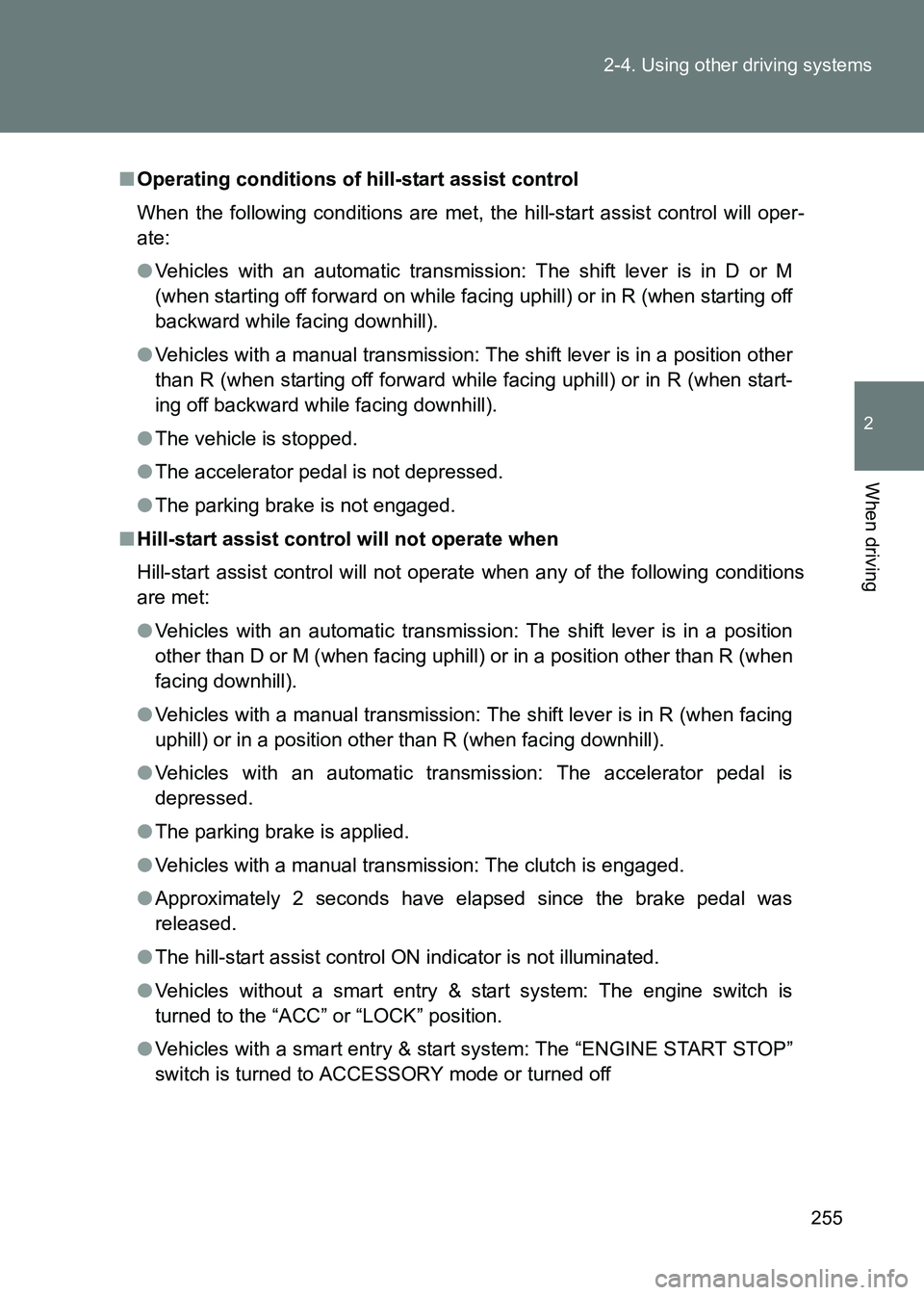
255
2-4. Using other driving systems
2
When driving
86_EE (OM18071E)
■
Operating conditions of hill-start assist control
When the following conditions are met, the hill-start assist control will oper-
ate:
●Vehicles with an automatic transmission: The shift lever is in D or M
(when starting off forward on while facing uphill) or in R (when starting off
backward while facing downhill).
● Vehicles with a manual transmission: The shift lever is in a position other
than R (when starting off forward while facing uphill) or in R (when start-
ing off backward while facing downhill).
● The vehicle is stopped.
● The accelerator pedal is not depressed.
● The parking brake is not engaged.
■ Hill-start assist control will not operate when
Hill-start assist control will not operate when any of the following conditions
are met:
●Vehicles with an automatic transmission: The shift lever is in a position
other than D or M (when facing uphill) or in a position other than R (when
facing downhill).
● Vehicles with a manual transmission: The shift lever is in R (when facing
uphill) or in a position other than R (when facing downhill).
● Vehicles with an automatic transmission: The accelerator pedal is
depressed.
● The parking brake is applied.
● Vehicles with a manual transmission: The clutch is engaged.
● Approximately 2 seconds have elapsed since the brake pedal was
released.
● The hill-start assist control ON indicator is not illuminated.
● Vehicles without a smart entry & start system: The engine switch is
turned to the “ACC” or “LOCK” position.
● Vehicles with a smart entry & start system: The “ENGINE START STOP”
switch is turned to ACCESSORY mode or turned off
Page 256 of 505
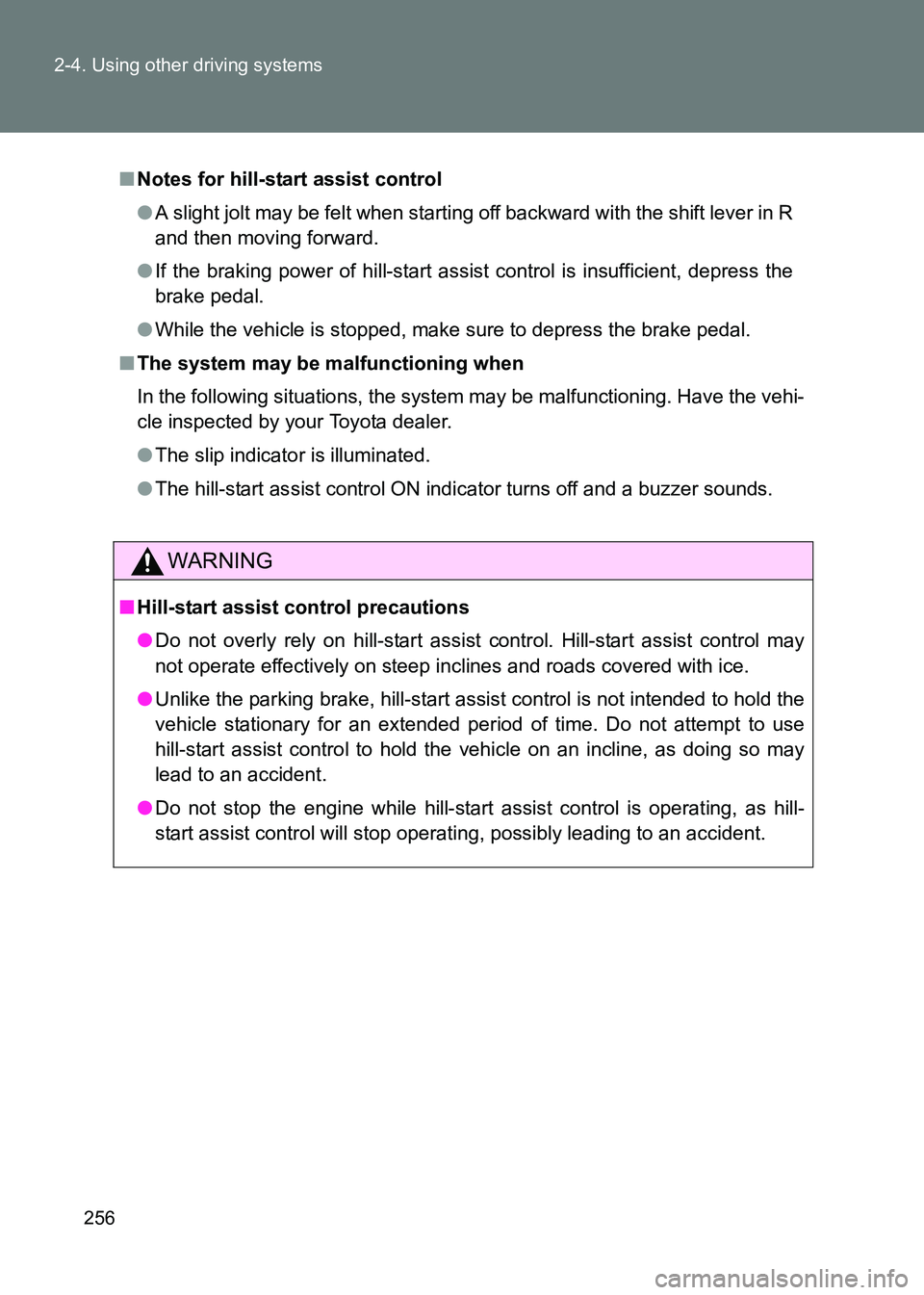
256
2-4. Using other driving systems
86_EE (OM18071E)
■
Notes for hill-start assist control
●A slight jolt may be felt when starting off backward with the shift lever in R
and then moving forward.
● If the braking power of hill-start assist control is insufficient, depress the
brake pedal.
● While the vehicle is stopped, make sure to depress the brake pedal.
■ The system may be malfunctioning when
In the following situations, the system may be malfunctioning. Have the vehi-
cle inspected by your Toyota dealer.
●The slip indicator is illuminated.
● The hill-start assist control ON indicator turns off and a buzzer sounds.
WARNING
■Hill-start assist control precautions
●Do not overly rely on hill-start assist control. Hill-start assist control may
not operate effectively on steep inclines and roads covered with ice.
● Unlike the parking brake, hill-start assist control is not intended to hold the
vehicle stationary for an extended period of time. Do not attempt to use
hill-start assist control to hold the vehicle on an incline, as doing so may
lead to an accident.
● Do not stop the engine while hill-start assist control is operating, as hill-
start assist control will stop operating, possibly leading to an accident.
Page 281 of 505
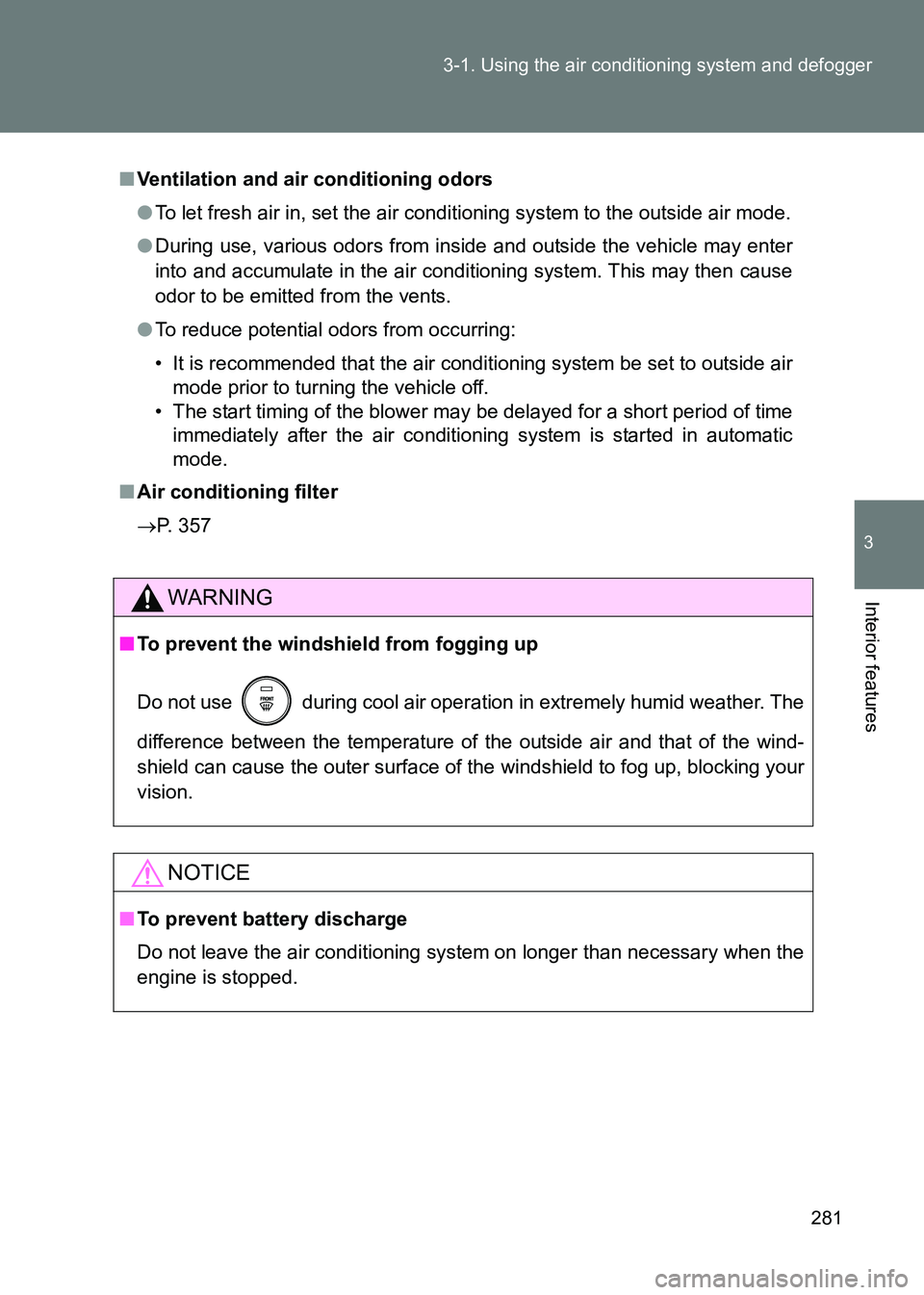
281
3-1. Using the air conditioning system and defogger
3
Interior features
86_EE (OM18071E)
■
Ventilation and air conditioning odors
●To let fresh air in, set the air condi tioning system to the outside air mode.
● During use, various odors from inside and outside the vehicle may enter
into and accumulate in the air conditioning system. This may then cause
odor to be emitted from the vents.
● To reduce potential odors from occurring:
• It is recommended that the air conditi oning system be set to outside air
mode prior to turning the vehicle off.
• The start timing of the blower may be delayed for a short period of time immediately after the air conditioning system is started in automatic
mode.
■ Air conditioning filter
→ P. 357
WARNING
■To prevent the windshield from fogging up
Do not use during cool air operation in extremely humid weather. The
difference between the temperature of the outside air and that of the wind-
shield can cause the outer surface of the windshield to fog up, blocking your
vision.
NOTICE
■To prevent battery discharge
Do not leave the air conditioning system on longer than necessary when the
engine is stopped.